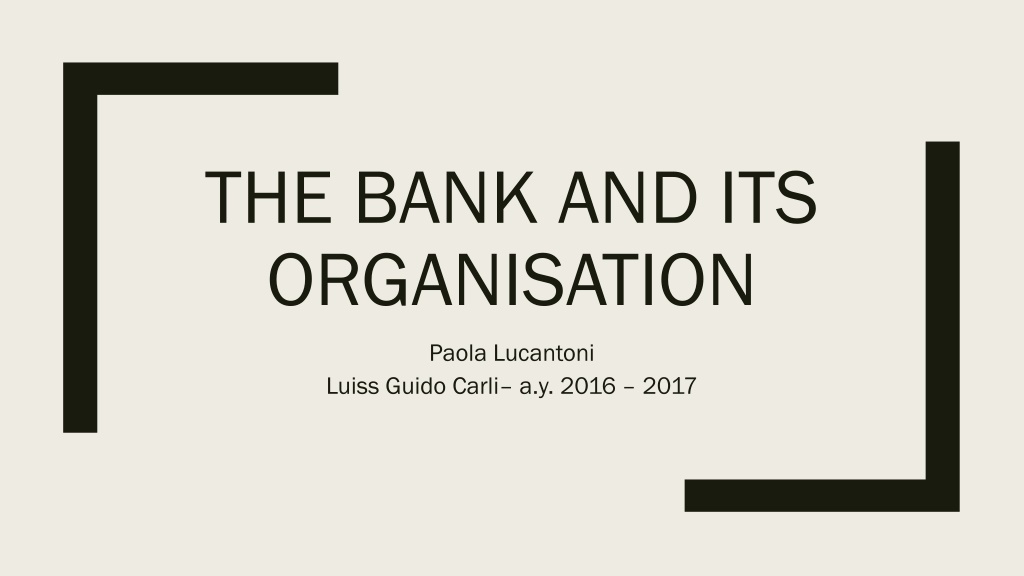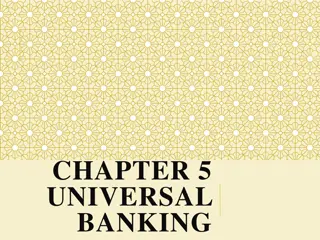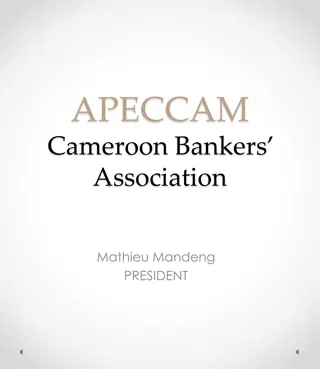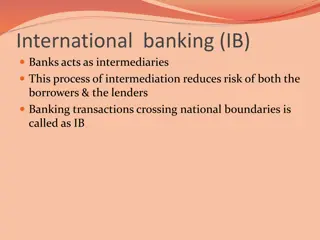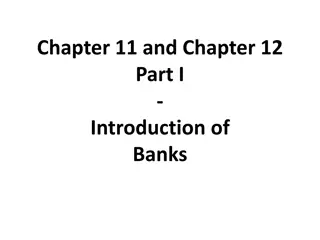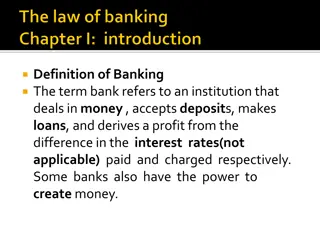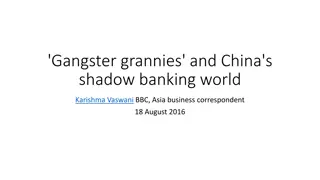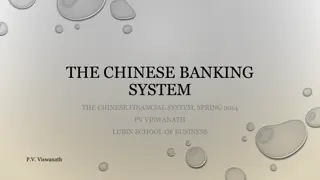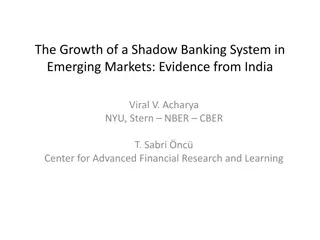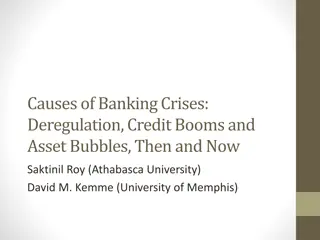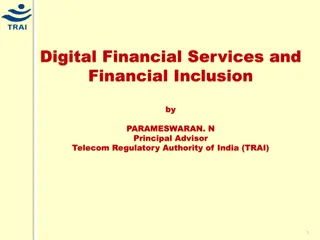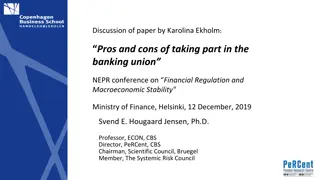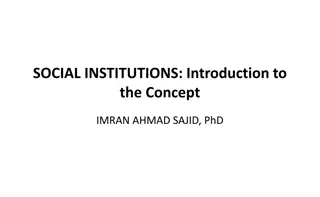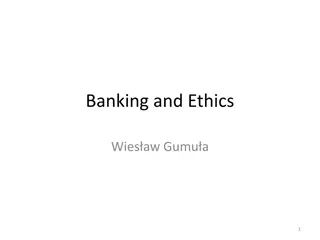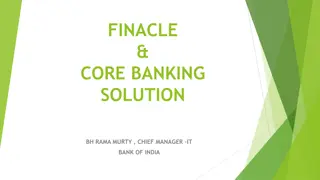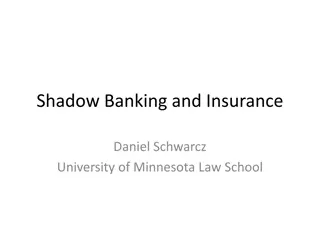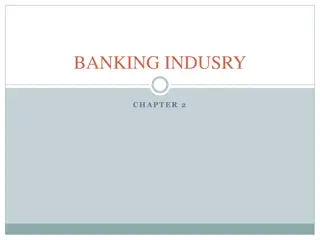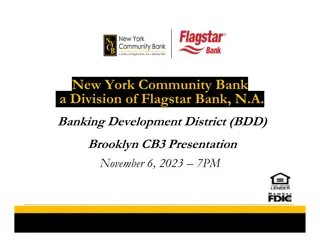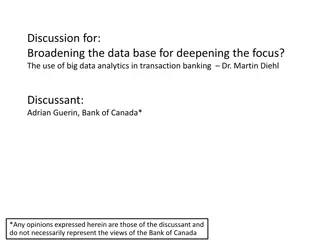Evolution of Banking Institutions: History, Practices, and Regulations
Delve into the evolution of banking institutions from money changers to modern commercial and investment banks. Explore the historical context, current practices, and regulatory frameworks governing banking activities at both the EU level and within individual Member States. Discover the distinctions between commercial and investment banks, as well as the organizational structures of universal and multifunctional banking groups. Gain insights into the profitability, reserved activities, and categorization of banks in the dynamic financial landscape.
Uploaded on Oct 02, 2024 | 0 Views
Download Presentation

Please find below an Image/Link to download the presentation.
The content on the website is provided AS IS for your information and personal use only. It may not be sold, licensed, or shared on other websites without obtaining consent from the author. Download presentation by click this link. If you encounter any issues during the download, it is possible that the publisher has removed the file from their server.
E N D
Presentation Transcript
THE BANK AND ITS ORGANISATION Paola Lucantoni Luiss Guido Carli a.y. 2016 2017
Banking business history and current practise From money changers to depositor takers Middle Age XIII Genoa XIV Venice Risk? Deposit and lendings - different time horizon Today s banking model business Obtaining deposits from customers Lending money to businesses, households and individuals
Bank as a credit institution Bank s activity is profitable if 1. spread between active interest and passive interest the money lent to business, households and individuals has a higher remuneration than that which is returned to the money deposited by them 2. transformation function of a bank the money deposit can be retrieved at any time by the customers the money borrowed is only due aftre a period of several years
Banking business a reserved activity At EU level, lending and borrowing are regulated and such practices are prohibited by non-authorised entities. CRD IV art. 8(1) and 9 (1) Each MS shall require credit institution to obtain authorisation before commencing their activities and shall prohibit persons or undertakings that are not credit institutions from carrying out the business of deposits or other repayable funds from the public .
Categories of banks activities commercial banks v. investment banks Commercial banks retail banking and commercial banking Retail customers Bank accounts to the general public Lending of money to business clients Network of branches Investment banks Advisory business Relating to corporate transactions M&A admission to trading
Categories of banks organisation Multifunctional groups v. universal banks Universal bank anglo-american model A monolithic entity which is in charge and responsible for everything Formally a single corporate entity Units and sections specialised in specific banking business commercial banking, investment banking, corporate finance Less expensive organisation single board Great diversification of the activity less risky Multifunctional group german model A parent company owns several corporate entities Each corporate entities operates the specific banking business More flexible model of business More expensive organisation multiple boards of directors No diversification of the activity more risky
Categories of banks organisation Multifunctional groups v. universal banks Regulation Risk? Deposits USA section 619 Dodd Frank Act Volcker Rule restricts deposit taking banks from engaging in certain types of market-oriented activities like proprietary trading Aim: to safegard the core of the banking system deposits and loans UK independent commission on banking chaired by Vickers recommended in 2011 that large UK banks should ring-fence their retail bank operations into large legal subsidiaries with their own prudential safeguards EU 2012- Report from the High Level Group chaired by Liikanen proprietary trading and other significant trading activities should be assigned to a separate legal entity if the activities to be separated amount to a significant share of a bank s business.
Branches A branch is the operating unit of the financial institution, usually located in close proximity to the area where that bank wishes to offer its product Not independent from a corporate point of view Business model: staff supervised by a local management structure which reports to the headquarter of the financial institution CRR 575/2013 a place of business which forms a legally independent part of a credit institution and which carries out directly all or some of the transactions inherent in the business of the institution
Subsidiaries Corporate entities owned, directly or indirectly, by the parent company of a banking group. Autonomous and independent from the board of directors of the holding company The directors of each subsidiaries reach decisions autonomously no hierarchical authorisation required CRD 2013/36 definition The control exercised by a bank over a company as a shareholder or, failing this, a dominant influence on that company would suffice as the standard which, if met, would qualify that company as a subsidiary
Banking groups Parent company and myriad subsidiaries Categorisation depends on the jurisdiction where the group is incorporated Consolidated account directive: If the undertaking has a majority of the shareholders voting rights in another undertaking (a subsidiary undertaking) or at least has the right to appoint or remove a majority of the members of the administrative, management or supervisory body of another undertaking and it is t the same time a shareholder in or member of that undertaking.
Bank and industry Osmosis between industry and banks is traditionally perceived to be a contentious issue. Risk of contagious in case on insolvency Conflicts of interests in non transparent money lending Profitability of the group in booming market conditions Chinese Walls endorsed by EU legislation
Bank and industry bank owning an industry CRR 89 subjects to limits not any qualifying holding by a bank but exclusively qualifying holdings of a credit institution outside financial sector exceeding 15 per cent of the capital of a bank the global limit of industrial holding must not exceed 60n per cent of the capital of the bank
Bank and industry Commercial businesses or industries owning a bank 22 CRD IV Any natural or legal person or such person acting in concern who have taken a decision either to acquire, directly or indirectly, such a qualifying holding in a credit institution must inform the competent authority. 20 %, 30%, 50 % the competent authority could deny authorisation within 60 days for the sound and prudent management of the bank applied for industry or other banks holdings in the bank
EU banking activities Deposits and lendings: banking activities CRD mutual recognition and home country control Also additional activities subject to mutual recognition with an intersection with investment firm regulation: Financial leasing Money transmission services Payment services Issuing and administering means of payment Advices to undertakings of capital structure Portfolio management and advices
